#biodiversity recording
Explore tagged Tumblr posts
Text
Unleash Your Inner Explorer: Dive into Biodiversity with the iNaturalist App
Are you ready to embark on a thrilling journey through Saskatoon and Area’s rich tapestry of wildlife and natural wonders? The Saskatoon and area City Nature Challenge is back, and this year, we’re inviting you to join us in an exhilarating adventure of discovery and conservation! iNaturalist Observation with smart phone connecting with nature, supporting vital conservation research…

View On WordPress
#adventure#biodiversity#Biodiversity Conservation#biodiversity monitoring#biodiversity recording#celebration#Citizen Science#City Nature Challenge#community#Community Engagement#Community Participation#conservation#Conservationists#discovery#diversity#Ecological Awareness#Ecosystem#empowerment#environmental advocacy#Environmental Education#environmental stewardship#exploration#Field Ants#George Genereux Urban REgional Park#global initiative#iNaturalist app#Mayflies#Mound Ants#natural wonders#Nature
0 notes
Note
i wanna hear your thoughts on chainsaw man, if you don't mind 👀
MY THOUGHTS, you say?

This is only about the anime as I haven’t read the manga or engaged much with csm at all besides that. and sorry that this is disjointed this is just my natural unfiltered sleep deprived word splatter
OKAY. so once I adapted to the graphic gore and constant sex jokes and channeled my inner edgy teenager and adjusted to how bizarre and alarming it was… I was surprised but I actually started to really enjoy it. because I feel the disjointed cynicism and humour and general awfulness of it fits this bleak awful universe it’s set in and makes it all the more believable
I really love the idea of an object or concept becoming a devil and having an appropriate level of threat and danger based on how people perceive it? and that it can change with major events and become worse over time and fluctuate. I think the concept is what got me hooked.
I really want to know more about the universe it’s set in. it’s fascinating to me. It was casually mentioned that the Soviet Union exists??? What year is this anime even set… Are nuclear weapons present in this universe? I feel that nuclear energy would be the most threatening devil but there’s been no mention of it. Or any epidemics? or natural disasters? instead the gun devil is the largest threat. also if the gun devil appeared in america why are bits of it all over japan? how did it get there? can devils cross oceans. do they do interplanar travel or something. do you get extremely culturally specific devils that are only found in specific countries. are there geographic influences. WHY is everyone suddenly so obsessed with denji when he just had a puppy chainsaw possess him
I loved the time loop episode and I really loved seeing the characters get fleshed out! I love the tiny bits of lovely mundane normality in the series too like aki just trying to live and do cooking and do the laundry which gets destroyed by denji and power turning up. poor fucking guy
Strange thought but now I’m wondering if people can be forcibly manipulated in order to deliberately increase the power of a devil? if you kidnapped 1,000 people and made them develop a severe phobia of spoons for example, would the spoon devil gain immense power. is that just how it works. can you merge devils persona style. what is the most contracts anyone has ever made, is there a world record?how do you stop ordinary people from making contracts?
If you can have devils as more abstract concepts could you end up with comic book villains or characters manifesting? memes? a situation where all popular media has to be very carefully controlled? how does consumerism and capitalism influence devils. I NEED THE LORE. have devils always existed or is this a recent phenomenon? if they’ve always existed then would older devils be stronger? ANCIENT SOCIETIES WITH DEVILS? dinosaur devil???
the christian imagery is interesting and I'm curious to see where it is going. especially that painting in the ending where makima is holding denji like mother mary holding jesus… interesting that all the graves are in western style too
if there’s an infinity devil is there gonna be a Death devil? contracts and devils they are so interesting to me. the devil hunters are SUCH assholes. the way denji and power are completely treated as tools and have no agency. the way aki is treated by pretty much everyone is ridiculous this guy can’t even eat his apples in hospital in peace. I would peel apples for him at his bedside. I LOVE aki. which is very typical of me I always fall for characters like him. I love characters doomed by the narrative and revenge driven. It’s terrifying and devastating but also morbidly hilarious seeing him battle with the depths of grief juxtaposed to the flippant attitude of everyone else who shrugs it off and can go back to laughing
I am also fascinated and in love with Makima. I have to know what her deal is. she can’t be human… I would listen to whatever she says and end up destroying the world for her <3 she is the girl manipulator of all time. THE BIT ON THE TRAIN AND THE HUMAN SACRIFICE SCENE… damn
Okay where was I going with this. So chainsaw man! it’s definitely not the usual kind of thing I’d watch, and I don’t think I’d have continued past the first two episodes if my friend hadn’t sat down and watched it with me. but I really am interested to see where it’s going? and kind of concerned now that I think about it. like if it is going to use any real world historical events, like wars? that’s probably my biggest fear, can't see that being done tactfully
BUT YEAH THE ANIMATION… was so good. MAPPA really is something else. and I love the openings and endings, I can’t believe every ending was different. insane anime. ultimately it’s a nightmare but I enjoyed it. might try to read the manga next so I can get some Answers
#watches an anime. me immediately: how would the archaeological record and biodiversity be influenced by this chaos#thank you so much mordecai for letting me ramble this was very cathartic!#answered
5 notes
·
View notes
Text
"A Scottish field once home to mono-crop barley has become a pollinator’s paradise after intervention from a local trust saw bumblebee numbers increase 100-fold.
Entitled Rewilding Denmarkfield, and run by the Bumblebee Conservation Trust, the project has also seen a sharp increase in the number of species passing through the rolling meadows after they were reclaimed by dozens of wildflower species.
The area north of Perth is about 90 acres in size, and surveys of bumblebees before the project began rarely recorded more than 50. But by 2023, just two years of letting “nature take the lead” that number has topped 4,000, with the number of different bee species doubling.
“This superb variety of plants attracts thousands of pollinators. Many of these plants, such as spear thistle and smooth hawk’s beard, are sometimes branded as ‘weeds’. But they are all native species that are benefiting native wildlife in different ways,” Ecologist Ellie Corsie, who has been managing the project since it began in 2021, said.
“Due to intensive arable farming, with decades of plowing, herbicide, and pesticide use, biodiversity was incredibly low when we started. Wildlife had largely been sanitized from the fields. Rewilding the site has had a remarkable benefit.”
Similar increases have been recorded in the populations of butterflies, with a tripling in the number of these insects seen on average during a ramble through the field.
The numbers of both insects are now so high that Rewilding Denmarkfield offers bee and butterfly safaris to visitors.
Local residents told the Scotsman that on spring and summer days, the field is awash with color, and hums with the sounds of bees and birds. Even as multiple housing developments expand around the Denmarkfield area, the field is a haven for wildlife."
-via Good News Network, December 2, 2024
#bees#bumblebee#save the bees#pollinators#conservation#sustainability#hope posting#insects#entomology#rewilding#scotland#europe#good news#hope
9K notes
·
View notes
Text
World faces ‘deathly silence’ of nature as wildlife disappears, warn experts
#bernie krause#field recording#biodiversity#Hildegard Westerkamp#World Soundscape Project#ecoacoustic monitoring#acoustic ecology
1 note
·
View note
Text
hey uh so I haven't seen anyone talking about this here yet, but
the amazon river, like the biggest river in the fucking world, in the middle of the amazon fucking rainforest, is currently going through its worst drought since the records began 121 years ago
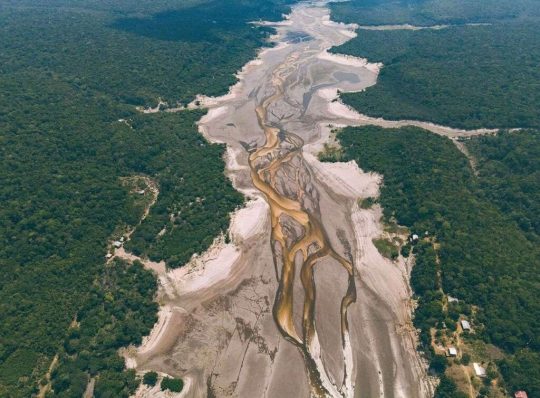
picture from Folha PE
there's a lot going on but I haven't seen much international buzz around this like there was when the forest was on fire (maybe because it's harder to shift the narrative to blame brazil exclusively as if the rest of the world didn't have fault in this) so I wanted to bring this to tumblr's attention
I don't know too many details as I live in the other side of the country and we are suffering from the exact opposite (at least three cyclones this year, honestly have stopped counting - it's unusual for us to get hit by even one - floods, landslides, we have a death toll, people are losing everything to the water), but like, I as a brazilian have literally never seen pictures of the river like this before. every single city in the amazonas state is in a state of emergency as of november 1st.
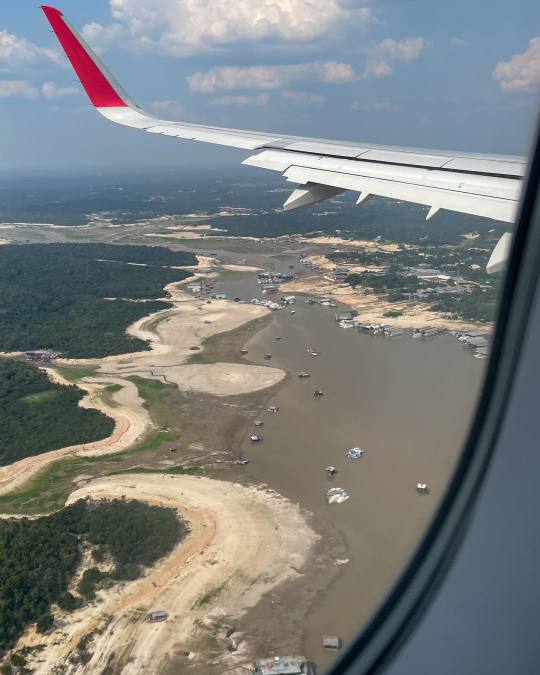

pictures by Adriano Liziero (ig: geopanoramas)
we are used to seeing images of rio negro and solimões, the two main amazon river affluents, in all their grandiose and beauty and seeing these pictures is really fucking chilling. some of our news outlets are saying the solimões has turned to a sand desert... can you imagine this watery sight turning into a desert in the span of a year?

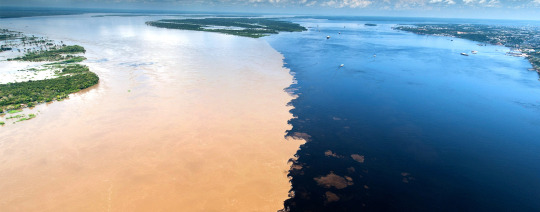
while down south we are seeing amounts of rain and hailstorms the likes of which our infrastructure is simply not built to deal with, up north people who have built everything around the river are at a loss of what to do.
the houses there that are built to float are just on the ground, people who depend on fishing for a living have to walk kilometers to find any fish that are still alive at all, the biodiversity there is at risk, and on an economic level it's hard to grasp how people from the northern states are getting by at all - the main means of transport for ANYTHING in that region is via the river water. this will impact the region for months to come. it doesnt make a lot of sense to build a lot of roads bc it's just better to use the waterway system, everything is built around or floats on the river after all. and like, the water level is so incomprehensibly low the boats are just STUCK. people are having a hard time getting from one place to another - keep in mind the widest parts of the river are over 10 km apart!!

this shit is really serious and i am trying not to think about it because we have a different kind of problem to worry about down south but it's really terrifying when I stop to think about it. you already know the climate crisis is real and the effects are beyond preventable now (we're past global warming, get used to calling it "global boiling"). we'll be switching strategies to damage control from now on and like, this is what it's come to.
I don't like to be alarmist but it's hard not to be alarmed. I'm sorry that I can't end this post with very clear intructions on how people overseas can help, there really isn't much to do except hope the water level rises soon, maybe pray if you believe in something. in that regard we just have to keep pressing for change at a global level; local conditions only would not, COULD NOT be causing this - the amazon river is a CONTINENTAL body of water, it spans across multiple countries. so my advice is spread the word, let your representatives know that you're worried and you want change towards sustainability, degrowth and reduced carbon emissions, support your local NGOs, maybe join a cause, I don't know? I recommend reading on ecological and feminist economics though
however, I know you can help the affected riverine families by donating to organizations dedicated to helping the region. keep in mind a single US dollar, pound or euro is worth over 5x more in our currency so anything you donate at all will certainly help those affected.
FAS - Sustainable Amazon Fundation
Idesam - Sustainable Developent and Preservation Institute of Amazonas
Greenpeace Brasil - I know Greenpeace isn't the best but they're one of the few options I can think of that have a bridge to the international world and they are helping directly
There are a lot of other smaller/local NGOs but I'm not sure how you could donate to them from overseas, I'll leave some of them here anyway:
Projeto Gari
Caritás Brasileira
If you know any other organizations please link them, I'll be sure to reblog though my reach isn't a lot
thank you so much for reading this to the end, don't feel obligated to share but please do if you can! even if you just read up to here it means a lot to me that someone out there knows
also as an afterthought, I wanted to expand on why I think this hasn't made big news yet: because unlike the case of the 2020 forest fires, other countries have to hold themselves accountable when looking at this situation. while in 2020 it was easier to pretend the fires were all our fault and people were talking about taking the amazon away from us like they wouldn't do much worse. global superpowers have no more forests to speak of so I guess they've been eyeing what latin america still has. so like this bit of the post is just to say if you're thinking of saying anything of the sort, maybe think of what your own country has done to contribute to this instead of blaming brazil exclusively and saying the amazon should be protected by force or whatever
#solarpunk#sustainability#environmentalism#climate change#climate crisis#global warming#amazon rainforest#amazon river#geography#brazil#degrowth#punk#global boiling#ecopunk#anti capitalism#climate action#climate activism#the world does not die on my watch#i saw someone use that tag and uh i like it we should make it a thing#long post#:/ sorry i know no one likes lengthy bad news posts on their dashes but i've been thinking about this quite a bit#and i don't really know what to do to help bc i don't have money to donate and i am 10 thousand km away#i think i could be doing more to help but i am already trying my best#again dont feel obligated to share or read this but it would be nice and i would love you forever#have removed lbv from the post
7K notes
·
View notes
Text
So this is a really creative solution to a pernicious ecological problem! The short version is that arid ecosystems like deserts are quite fragile. For example, many have soil that is covered in a thin biocrust that can be damaged just by walking or driving on it. And because life needs water to grow and recover, these super-dry ecosystems may not be able to repair a footprint or tire track for over a century.
However, arid ecosystems are often some of the least understood because they can be difficult to access. And they suffer from P.R. issues because deserts are often seen as "bad" ecosystems full of death and nothingness, and because we do legitimately want to avoid the desertification of other native habitats.
In order to raise awareness and appreciation of these landscapes, biological surveys that tally the living beings found there help show how biodiverse they can be. And when we know more about how abundant or scarce a given species there is, it gives us more impetus to protect them, especially those that are at risk of extinction.
These paramotorists were able to fly across Peru's lomas (coastal fog deserts), which primarily receive scant amounts of moisture from mist. They collected plant samples to take back to scientists, carefully recording where they were found. And because they were able to fly long distances, they could minimize the amount of time their feet were on the ground and therefore minimize their impact on the local ecology.
At a time where it seems every interaction between motorized technology and nature is a negative one, this is a pleasant departure. yes, of course we wish we weren't in a place where we have to be worried about increasing extinction and other ecological woes. But let's take the wins where we can; the morale boost is crucial to being able to keep looking toward a better future.
#desert#lomas#ecology#botany#plants#native plants#science#scicomm#nature#endangered species#extinction#environment#conservation#biology#hopepunk#good news#paramotor#paragliding
498 notes
·
View notes
Text

A new species of the genus Amolops (Anura, Ranidae) from the Gaoligong Mountains, China
Yun-He Wu, Zhong-Bin Yu, Felista Kasyoka Kilunda, Chen-Qi Lu, Jia-Hua Li, Yun-Peng Li, Yi-Juan Shi, Jing Che
Abstract
The Gaoligong Mountains lie at the intersection of three global biodiversity hotspots. In recent years, with the continuous deepening of fieldwork in the region, studies have increasingly indicated that the amphibian diversity of this region remains poorly understood. During herpetological surveys in 2023, a series of Amolops specimens were collected from the Gaoligong Mountains of Yunnan Province, China. The integrated results of morphological and molecular phylogenetic analyses indicate the presence of a separate and previously unknown lineage in the A. viridimaculatus group, which we herein confirm as a new species, Amolops gudao Yu, Wu, Lu & Che, sp. nov. Our discovery increases the number of Amolops species recorded in China to 59, and the total number of Amolops species to 86. The discovery of a new species in the Gaoligong Mountains further highlights the underestimated amphibian diversity in the region, emphasizing the need for continued fieldwork and research. Furthermore, Amolops gudao Yu, Wu, Lu & Che, sp. nov. exhibits obvious intraspecific variation in color patterns, a phenomenon also reported in several species within the A. viridimaculatus group, such as A. viridimaculatus and A. kaulbacki. Future studies on the taxonomy of A. viridimaculatus group should be careful with the use of color patterns as a diagnostic characteristic.
Read the paper here:
A new species of the genus Amolops (Anura, Ranidae) from the Gaoligong Mountains, China
209 notes
·
View notes
Text

The Summer Games are here, so let’s meet the gold medal champion for fastest shark in the sea: the shortfin mako shark (Isurus oxyrinchus)! This agile predator fish is one of the world’s fastest swimmers, able to reach a top speed of over 40 mph (64.3 kmh). For perspective, the current 100m freestyle world record holder swam at an overall speed of 4.7 mph (2.9 km/h). A model of this shark can be found in the Museum's Hall of Biodiversity.
Want to learn more? Become a Museum Member today! Plus, use promo code GAMES24 and we’ll include a FREE, limited-edition Summer Games tote bag.
Photo: Alison Kock, CC BY-NC 4.0, iNaturalist
#science#museum#nature#natural history#animals#fact of the day#did you know#cool animals#sharks#mako shark#shortfin mako shark#olympics#swimming
471 notes
·
View notes
Text
Good News - July 15-21
Like these weekly compilations? Tip me at $kaybarr1735! (Or check out my new(ly repurposed) Patreon!)
1. Thai tiger numbers swell as prey populations stabilize in western forests

“The tiger population density in a series of protected areas in western Thailand has more than doubled over the past two decades, according to new survey data. […] The most recent year of surveys, which concluded in November 2023, photographed 94 individual tigers, up from 75 individuals in the previous year, and from fewer than 40 in 2007. […] A total of 291 individual tigers older than 1 year were recorded, as well as 67 cubs younger than 1 year.”
2. Work starts to rewild former cattle farm

“Ecologists have started work to turn a former livestock farm into a nature reserve [… which] will become a "mosaic of habitats" for insects, birds and mammals. [… R]ewilding farmland could benefit food security locally by encouraging pollinators, improving soil health and soaking up flood water. [… “N]ature restoration doesn't preclude food production. We want to address [food security] by using nature-based solutions."”
3. Harnessing ‘invisible forests in plain view’ to reforest the world

“[… T]he degraded land contained numerous such stumps with intact root systems capable of regenerating themselves, plus millions of tree seeds hidden in the soil, which farmers could simply encourage to grow and reforest the landscape[….] Today, the technique of letting trees resprout and protecting their growth from livestock and wildlife [… has] massive potential to help tackle biodiversity loss and food insecurity through resilient agroforestry systems. [… The UN’s] reported solution includes investing in land restoration, “nature-positive” food production, and rewilding, which could return between $7 and $30 for every dollar spent.”
4. California bars school districts from outing LGBTQ+ kids to their parents

“Gov. Gavin Newsom signed the SAFETY Act today – a bill that prohibits the forced outing of transgender and gay students, making California the first state to explicitly prohibit school districts from doing so. […] Matt Adams, a head of department at a West London state school, told PinkNews at the time: “Teachers and schools do not have all the information about every child’s home environment and instead of supporting a pupil to be themselves in school, we could be putting them at risk of harm.””
5. 85% of new electricity built in 2023 came from renewables

“Electricity supplied by renewables, like hydropower, solar, and wind, has increased gradually over the past few decades — but rapidly in recent years. [… C]lean energy now makes up around 43 percent of global electricity capacity. In terms of generation — the actual power produced by energy sources — renewables were responsible for 30 percent of electricity production last year. […] Along with the rise of renewable sources has come a slowdown in construction of non-renewable power plants as well as a move to decommission more fossil fuel facilities.”
6. Deadly cobra bites to "drastically reduce" as scientists discover new antivenom

“After successful human trials, the snake venom antidote could be rolled out relatively quickly to become a "cheap, safe and effective drug for treating cobra bites" and saving lives around the globe, say scientists. Scientists have found that a commonly used blood thinner known as heparin can be repurposed as an inexpensive antidote for cobra venom. […] Using CRISPR gene-editing technology […] they successfully repurposed heparin, proving that the common blood thinner can stop the necrosis caused by cobra bites.”
7. FruitFlow: a new citizen science initiative unlocks orchard secrets

“"FruitWatch" has significantly refined phenological models by integrating extensive citizen-sourced data, which spans a wider geographical area than traditional methods. These enhanced models offer growers precise, location-specific predictions, essential for optimizing agricultural planning and interventions. […] By improving the accuracy of phenological models, farmers can better align their operations with natural biological cycles, enhancing both yield and quality.”
8. July 4th Means Freedom for Humpback Whale Near Valdez, Alaska

“The NOAA Fisheries Alaska Marine Mammal Stranding Hotline received numerous reports late afternoon on July 3. A young humpback whale was entangled in the middle of the Port of Valdez[….] “The success of this mission was due to the support of the community, as they were the foundation of the effort,” said Moran. [… Members of the community] were able to fill the critical role of acting as first responders to a marine mammal emergency. “Calling in these reports is extremely valuable as it allows us to respond when safe and appropriate, and also helps us gain information on various threats affecting the animals,” said Lyman.”
9. Elephants Receive First of Its Kind Vaccine

“Elephant endotheliotropic herpesvirus is the leading cause of death for Asian elephants (Elephas maximus) born in facilities in North America and also causes calf deaths in the wild in Asia. A 40-year-old female received the new mRNA vaccine, which is expected to help the animal boost immunity[….]”
10. Conservation partners and Indigenous communities working together to restore forests in Guatemala

“The K’iche have successfully managed their natural resources for centuries using their traditional governing body and ancestral knowledge. As a result, Totonicapán is home to Guatemala’s largest remaining stand of conifer forest. […] EcoLogic has spearheaded a large-scale forest restoration project at Totonicapán, where 13 greenhouses now hold about 16,000 plants apiece, including native cypresses, pines, firs, and alders. […] The process begins each November when community members gather seeds. These seeds then go into planters that include upcycled coconut fibers and mycorrhizal fungi, which help kickstart fertilization. When the plantings reach about 12 inches, they’re ready for distribution.”
July 8-14 news here | (all credit for images and written material can be found at the source linked; I don’t claim credit for anything but curating.)
#hopepunk#good news#tiger#thailand#habitat#rewilding#food insecurity#forest#reforestation#california#lgbtq#lgbtqia#students#law#trans rights#gay rights#renewableenergy#clean energy#snake#medicine#crispr#citizen science#farming#whale#humpback whale#elephant#vaccine#alaska#guatemala#indigenous
452 notes
·
View notes
Text
I mean… this is why I’m so hesitant to get my autism diagnosis. I still might go ahead and get it, if only to add to the scientific body of work of all the undiagnosed PGM AFABs out there.
Right now, I’m on a path of learning more about myself and letting myself be… me. A person who can do a lot of things but can’t do certain things (or needs help with them). It’s incredibly vulnerable and scary already to admit disability on the record. I am an academic who relies on their “knowledge” and “skills” honed over time… and I can’t always rely on my body (due to autoimmune conditions that flare up majorly when I mask or I’m not honoring my needs). So to pursue an autism diagnosis when people already stigmatize stuff like “intelligence”…. it is incredibly dicey.
And I’m walking this path (not just neurodivergence… but being queer and trans, being a victim of emotional abuse, being a victim of physical abuse, etc.) more publicly than ever before. What was my other choice? Be in one autoimmune crisis after another while people bullied me for my quirks anyway?
Human difference and biodiversity are incredibly complex and deserve nuanced discussions.
Something that seems to really trip people up about posts discussing psychiatry etc pathologizing human difference is the assumption that the phrase "human difference" is a purely positive one. Like the assumption that people saying "psychiatry pathologizes normal human difference" is saying that human difference is never unpleasant or difficult to handle or human difference never results in suffering or struggle. Why would you assume that! This isn't a preschool level statement about how we are all different and that's okay. It's a morally neutral statement about human difference being a naturally occurring phenomenon and also about how human difference does not justify a violation of human RIGHTS. People will be like "but *I* genuinely have *diagnosis* and it makes my life harder" well good news that's not at all incompatible with the idea that the differences that are being classed as *diagnosis* don't justify you being medicated or institutionalized against your will, discriminated against, or prevented from accessing your basic needs!
If none of the things I just listed are problems you have personally run into due to *diagnosis*, may I humbly suggest that perhaps this conversation is not primarily about you.
#neurodivergence#human difference#neurodiversity#biodiversity#autism#masking#accessibility#human rights#love#pgm#poc#afab autism#undiagnosed something#diagnosis is an official record
302 notes
·
View notes
Text
As the link between animal agriculture and climate breakdown becomes clearer, if anything, we are seeing more ordinary people falling over themselves to defend an industry that is destroying our planet, polluting our communities, exploiting animals and human workers. This is especially worrying to see from leftists, in spaces that are supposed to be progressive. I promise you, you do not need to spend your time greenwashing leather and wool, repeating blatant industry propaganda about veganism, 'regenerative agriculture' or whatever other buzzword they're using to sow doubt this week. The industry already spends millions of your dollars to lobby our politicians and influence public opinion; they don't need you to do it for free.
Vox – The greenwashing of wool explained
New Republic – The comforting lie of climate-friendly meat
Guardian – Big Beef’s climate messaging machine
The Breakthrough – Is Feedlot Beef Better for Environment?
International Journey of Biodiversity – Misinformation on Science of Grazed Ecosystems
Food Climate Research Network – Grazed & Confused
Science 2.0 – The regenerative ranching racket
DeSmog – A guide to six greenwashing terms
Truthdig – The backlash to plant-based meats
Independent – Meat & dairy industries downplaying role in climate crisis using tobacco tactics
Guardian – Meat & dairy lobbyists turn out in record numbers at COP28
Greenpeace – How Big Agriculture is borrowing Big Oil’s playbook at COP28
Guardian – Plans to present meat as ‘sustainable nutrition’ at Cop28 revealed
Guardian – Ex-officials at UN farming body say work on methane emissions was censored
Guardian – How UN food body played down role of farming in climate change
QZ – The meat industry blocked the IPCC’s attempt to recommend a plant-based diet
The Times – Red Tractor farms more likely to pollute environment
Influence Map – European meat & dairy industry weaken EU’s climate policies
The Grocer – Meat Industry lobbying behind cultured meat bans
Food Unfolded – Truth, tactics and the mist of meat lobby science
Business Green – Climate lobbying: Are meat and dairy lobbyists the ‘new merchants of doubt’?
246 notes
·
View notes
Text
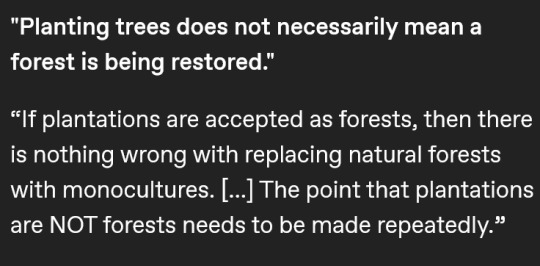
Despite its green image, Ireland has surprisingly little forest. [...] [M]ore than 80% of the island of Ireland was [once] covered in trees. [...] [O]f that 11% of the Republic of Ireland that is [now] forested, the vast majority (9% of the country) is planted with [non-native] spruces like the Sitka spruce [in commercial plantations], a fast growing conifer originally from Alaska which can be harvested after just 15 years. Just 2% of Ireland is covered with native broadleaf trees.
Text by: Martha O’Hagan Luff. “Ireland has lost almost all of its native forests - here’s how to bring them back.” The Conversation. 24 February 2023. [Emphasis added.]
---
[I]ndustrial [...] oil palm plantations [...] have proliferated in tropical regions in many parts of the world, often built at the expense of mangrove and humid forest lands, with the aim to transform them from 'worthless swamp' to agro-industrial complexes [...]. Another clear case [...] comes from the southernmost area in the Colombian Pacific [...]. Here, since the early 1980s, the forest has been destroyed and communities displaced to give way to oil palm plantations. Inexistent in the 1970s, by the mid-1990s they had expanded to over 30,000 hectares. The monotony of the plantation - row after row of palm as far as you can see, a green desert of sorts - replaced the diverse, heterogenous and entangled world of forest and communities.
Text by: Arturo Escobar. "Thinking-Feeling with the Earth: Territorial Struggles and the Ontological Dimension of the Epistemologies of the South." Revista de Antropologia Iberoamericana Volume 11 Issue 1. 2016. [Emphasis added.]
---
But efforts to increase global tree cover to limit climate change have skewed towards erecting plantations of fast-growing trees [...] [because] planting trees can demonstrate results a lot quicker than natural forest restoration. [...] [But] ill-advised tree planting can unleash invasive species [...]. [In India] [t]o maximize how much timber these forests yielded, British foresters planted pines from Europe and North America in extensive plantations in the Himalayan region [...] and introduced acacia trees from Australia [...]. One of these species, wattle (Acacia mearnsii) [...] was planted in [...] the Western Ghats. This area is what scientists all a biodiversity hotspot – a globally rare ecosystem replete with species. Wattle has since become invasive and taken over much of the region’s mountainous grasslands. Similarly, pine has spread over much of the Himalayas and displaced native oak trees while teak has replaced sal, a native hardwood, in central India. Both oak and sal are valued for [...] fertiliser, medicine and oil. Their loss [...] impoverished many [local and Indigenous people]. [...]
India’s national forest policy [...] aims for trees on 33% of the country’s area. Schemes under this policy include plantations consisting of a single species such as eucalyptus or bamboo which grow fast and can increase tree cover quickly, demonstrating success according to this dubious measure. Sometimes these trees are planted in grasslands and other ecosystems where tree cover is naturally low. [...] The success of forest restoration efforts cannot be measured by tree cover alone. The Indian government’s definition of ��forest” still encompasses plantations of a single tree species, orchards and even bamboo, which actually belongs to the grass family. This means that biennial forest surveys cannot quantify how much natural forest has been restored, or convey the consequences of displacing native trees with competitive plantation species or identify if these exotic trees have invaded natural grasslands which have then been falsely recorded as restored forests. [...] Planting trees does not necessarily mean a forest is being restored. And reviving ecosystems in which trees are scarce is important too.
Text by: Dhanapal Govindarajulu. "India was a tree planting laboratory for 200 years - here are the results." The Conversation. 10 August 2023. [Emphasis added.]
---
Nations and companies are competing to appropriate the last piece of available “untapped” forest that can provide the most amount of “environmental services.” [...] When British Empire forestry was first established as a disciplinary practice in India, [...] it proscribed private interests and initiated a new system of forest management based on a logic of utilitarian [extraction] [...]. Rather than the actual survival of plants or animals, the goal of this forestry was focused on preventing the exhaustion of resource extraction. [...]
Text by: Daniel Fernandez and Alon Schwabe. "The Offsetted." e-flux Architecture (Positions). November 2013. [Emphasis added.]
---
At first glance, the statistics tell a hopeful story: Chile’s forests are expanding. […] On the ground, however, a different scene plays out: monocultures have replaced diverse natural forests [...]. At the crux of these [...] narratives is the definition of a single word: “forest.” [...] Pinochet’s wave of [...] [laws] included Forest Ordinance 701, passed in 1974, which subsidized the expansion of tree plantations [...] and gave the National Forestry Corporation control of Mapuche lands. This law set in motion an enormous expansion in fiber-farms, which are vast expanses of monoculture plantations Pinus radiata and Eucalyptus species grown for paper manufacturing and timber. [T]hese new plantations replaced native forests […]. According to a recent study in Landscape and Urban Planning, timber plantations expanded by a factor of ten from 1975 to 2007, and now occupy 43 percent of the South-central Chilean landscape. [...] While the confusion surrounding the definition of “forest” may appear to be an issue of semantics, Dr. Francis Putz [...] warns otherwise in a recent review published in Biotropica. […] Monoculture plantations are optimized for a single product, whereas native forests offer [...] water regulation, hosting biodiversity, and building soil fertility. [...][A]ccording to Putz, the distinction between plantations and native forests needs to be made clear. “[...] [A]nd the point that plantations are NOT forests needs to be made repeatedly [...]."
Text by: Julian Moll-Rocek. “When forests aren’t really forests: the high cost of Chile’s tree plantations.” Mongabay. 18 August 2014. [Emphasis added.]
#abolition#ecology#imperial#colonial#landscape#haunted#indigenous#multispecies#interspecies#temporality#carceral geography#plantations#ecologies#tidalectics#intimacies of four continents#archipelagic thinking#caribbean
2K notes
·
View notes
Text
Shining a light on the origins of bioluminescence ✨✨
A new study led by MBARI collaborators at the Smithsonian’s National Museum of Natural History explores the evolution of bioluminescence, nature’s living light show. A team of researchers, including MBARI Senior Scientist Steven Haddock, has learned bioluminescence first evolved in animals at least 540 million years ago in soft corals.
Scientists have long been curious about the evolution of bioluminescence. To tackle the larger question of why bioluminescence evolved, we needed to know when this ability first appeared in animals. In search of the trait’s earliest origins, the team decided to peer back into the evolutionary history of octocorals, an ancient and frequently bioluminescent group of animals that includes soft corals, sea fans, and sea pens.
Mapping out the branches of the evolutionary tree from fossil records, genetics, and bioluminescent behaviors revealed that some 540 million years ago, the common ancestor of all octocorals was very likely bioluminescent. That is 273 million years earlier than the glowing ostracod crustaceans that previously held the title of earliest evolution of bioluminescence in animals.
MBARI’s Biodiversity and Biooptics Team is working to understand how and why animals produce their stunning luminescence. Learn more about this illuminating research on our website.
148 notes
·
View notes
Text
Here's the top 2 stories from each of Fix The News's six categories:

1. A game-changing HIV drug was the biggest story of 2024
In what Science called the 'breakthrough of the year', researchers revealed in June that a twice-yearly drug called lenacapavir reduced HIV infections in a trial in Africa to zero—an astonishing 100% efficacy, and the closest thing to a vaccine in four decades of research. Things moved quick; by October, the maker of the drug, Gilead, had agreed to produce an affordable version for 120 resource-limited countries, and by December trials were underway for a version that could prevent infection with just a single shot per year. 'I got cold shivers. After all our years of sadness, particularly over vaccines, this truly is surreal.'
2. Another incredible year for disease elimination
Jordan became the first country to eliminate leprosy, Chad eliminated sleeping sickness, Guinea eliminated maternal and neonatal tetanus, Belize, Jamaica, and Saint Vincent & the Grenadines eliminated mother-to-child transmission of HIV and syphilis, India achieved the WHO target for eliminating black fever, India, Viet Nam and Pakistan eliminated trachoma, the world’s leading infectious cause of blindness, and Brazil and Timor Leste eliminated elephantiasis.
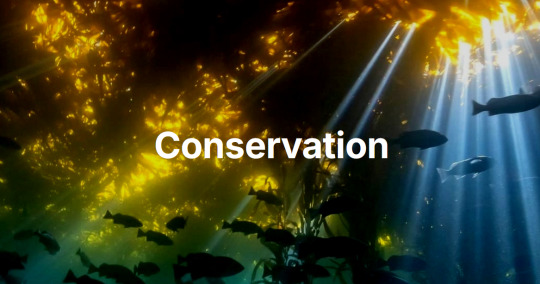
15. The EU passed a landmark nature restoration law
When countries pass environmental legislation, it’s big news; when an entire continent mandates the protection of nature, it signals a profound shift. Under the new law, which passed on a knife-edge vote in June 2024, all 27 member states are legally required to restore at least 20% of land and sea by 2030, and degraded ecosystems by 2050. This is one of the world’s most ambitious pieces of legislation and it didn’t come easy; but the payoff will be huge - from tackling biodiversity loss and climate change to enhancing food security.
16. Deforestation in the Amazon halved in two years
Brazil’s space agency, INPE, confirmed a second consecutive year of declining deforestation in the Brazilian Amazon. That means deforestation rates have roughly halved under Lula, and are now approaching all time lows. In Colombia, deforestation dropped by 36%, hitting a 23-year low. Bolivia created four new protected areas, a huge new new state park was created in Pará to protect some of the oldest and tallest tree species in the tropical Americas and a new study revealed that more of the Amazon is protected than we originally thought, with 62.4% of the rainforest now under some form of conservation management.

39. Millions more children got an education
Staggering statistics incoming: between 2000 and 2023, the number of children and adolescents not attending school fell by nearly 40%, and Eastern and Southern Africa, achieved gender parity in primary education, with 25 million more girls are enrolled in primary school today than in the early 2000s. Since 2015, an additional 110 million children have entered school worldwide, and 40 million more young people are completing secondary school.
40. We fed around a quarter of the world's kids at school
Around 480 million students are now getting fed at school, up from 319 million before the pandemic, and 104 countries have joined a global coalition to promote school meals, School feeding policies are now in place in 48 countries in Africa, and this year Nigeria announced plans to expand school meals to 20 million children by 2025, Kenya committed to expanding its program from two million to ten million children by the end of the decade, and Indonesia pledged to provide lunches to all 78 million of its students, in what will be the world's largest free school meals program.

50. Solar installations shattered all records
Global solar installations look set to reach an unprecedented 660GW in 2024, up 50% from 2023's previous record. The pace of deployment has become almost unfathomable - in 2010, it took a month to install a gigawatt, by 2016, a week, and in 2024, just 12 hours. Solar has become not just the cheapest form of new electricity in history, but the fastest-growing energy technology ever deployed, and the International Energy Agency said that the pace of deployment is now ahead of the trajectory required for net zero by 2050.
51. Battery storage transformed the economics of renewables
Global battery storage capacity surged 76% in 2024, making investments in solar and wind energy much more attractive, and vice-versa. As with solar, the pace of change stunned even the most cynical observers. Price wars between the big Chinese manufacturers pushed battery costs to record lows, and global battery manufacturing capacity increased by 42%, setting the stage for future growth in both grid storage and electric vehicles - crucial for the clean flexibility required by a renewables-dominated electricity system. The world's first large-scale grid battery installation only went online seven years ago; by next year, global battery storage capacity will exceed that of pumped hydro.

65. Democracy proved remarkably resilient in a record year of elections
More than two billion people went to the polls this year, and democracy fared far better than most people expected, with solid voter turnout, limited election manipulation, and evidence of incumbent governments being tamed. It wasn't all good news, but Indonesia saw the world's biggest one day election, Indian voters rejected authoritarianism, South Korea's democratic institutions did the same, Bangladesh promised free and fair elections following a 'people's victory', Senegal, Sri Lanka and Botswana saw peaceful transfers of power to new leaders after decades of single party rule, and Syria saw the end of one of the world's most horrific authoritarian regimes.
66. Global leaders committed to ending violence against children
In early November, while the eyes of the world were on the US election, an event took place that may prove to be a far more consequential for humanity. Five countries pledged to end corporal punishment in all settings, two more pledged to end it in schools, and another 12, including Bangladesh and Nigeria, accepted recommendations earlier in the year to end corporal punishment of children in all settings. In total, in 2024 more than 100 countries made some kind of commitment to ending violence against children. Together, these countries are home to hundreds of millions of children, with the WHO calling the move a 'fundamental shift.'

73. Space exploration hit new milestones
NASA’s Europa Clipper began a 2.9 billion kilometre voyage to Jupiter to investigate a moon that may have conditions for life; astronomers identified an ice world with a possible atmosphere in the habitable zone; and the James Webb Telescope found the farthest known galaxy. Closer to Earth, China landed on the far side of the moon, the Polaris Dawn crew made a historic trip to orbit, and Starship moved closer to operational use – and maybe one day, to travel to Mars.
74. Next-generation materials advanced
A mind-boggling year for material science. Artificial intelligence helped identify a solid-state electrolyte that could slash lithium use in batteries by 70%, and an Apple supplier announced a battery material that can deliver around 100 times better energy density. Researchers created an insulating synthetic sapphire material 1.25 nanometers thick, plus the world’s thinnest lens, just three atoms across. The world’s first functioning graphene-based semiconductor was unveiled (the long-awaited ‘wonder material’ may finally be coming of age!) and a team at Berkeley invented a fluffy yellow powder that could be a game changer for removing carbon from the atmosphere.
-via Fix The News, December 19, 2024
#renumbered this to reflect the article numbering#and highlight just how many stories of hope there are#and how many successes each labeled story contains#2024#good news#hope#hope posting#hopeposting#hopepunk#conservation#sustainability#public health#energy#quality of life#human rights#science and technology
3K notes
·
View notes
Text
Excerpt from this Op-Ed from the New York Times:
At first glance, Xi Jinping seems to have lost the plot.
China’s president appears to be smothering the entrepreneurial dynamism that allowed his country to crawl out of poverty and become the factory of the world. He has brushed aside Deng Xiaoping’s maxim “To get rich is glorious” in favor of centralized planning and Communist-sounding slogans like “ecological civilization” and “new, quality productive forces,” which have prompted predictions of the end of China’s economic miracle.
But Mr. Xi is, in fact, making a decades-long bet that China can dominate the global transition to green energy, with his one-party state acting as the driving force in a way that free markets cannot or will not. His ultimate goal is not just to address one of humanity’s most urgent problems — climate change — but also to position China as the global savior in the process.
It has already begun. In recent years, the transition away from fossil fuels has become Mr. Xi’s mantra and the common thread in China’s industrial policies. It’s yielding results: China is now the world’s leading manufacturer of climate-friendly technologies, such as solar panels, batteries and electric vehicles. Last year the energy transition was China’s single biggest driver of overall investment and economic growth, making it the first large economy to achieve that.
This raises an important question for the United States and all of humanity: Is Mr. Xi right? Is a state-directed system like China’s better positioned to solve a generational crisis like climate change, or is a decentralized market approach — i.e., the American way — the answer?
How this plays out could have serious implications for American power and influence.
Look at what happened in the early 20th century, when fascism posed a global threat. America entered the fight late, but with its industrial power — the arsenal of democracy — it emerged on top. Whoever unlocks the door inherits the kingdom, and the United States set about building a new architecture of trade and international relations. The era of American dominance began.
Climate change is, similarly, a global problem, one that threatens our species and the world’s biodiversity. Where do Brazil, Pakistan, Indonesia and other large developing nations that are already grappling with the effects of climate change find their solutions? It will be in technologies that offer an affordable path to decarbonization, and so far, it’s China that is providing most of the solar panels, electric cars and more. China’s exports, increasingly led by green technology, are booming, and much of the growth involves exports to developing countries.
From the American neoliberal economic viewpoint, a state-led push like this might seem illegitimate or even unfair. The state, with its subsidies and political directives, is making decisions that are better left to the markets, the thinking goes.
But China’s leaders have their own calculations, which prioritize stability decades from now over shareholder returns today. Chinese history is littered with dynasties that fell because of famines, floods or failures to adapt to new realities. The Chinese Communist Party’s centrally planned system values constant struggle for its own sake, and today’s struggle is against climate change. China received a frightening reminder of this in 2022, when vast areas of the country baked for weeks under a record heat wave that dried up rivers, withered crops and was blamed for several heatstroke deaths.
145 notes
·
View notes
Text
Rainbow Jumping Spider (Chrysilla volupe): these colorful spiders were regarded as an extinct species for nearly 150 years, until they were finally rediscovered in 2018

The males of this species have a stunning, almost rainbow-like appearance, thanks to the bands of color and iridescent scales that cover their bodies.

Despite the fact that Chrysilla volupe is probably the most flamboyant spider in the world, it was still lost to science for nearly 150 years. The species was first described in 1879, but there were no documented sightings of it for 139 years after that, until researchers finally tracked it down again in 2018. The female of this species was also described for the very first time in 2018 -- prior to that, Chrysilla volupe was known only from male specimens.

The spiders have been found in certain parts of India, Sri Lanka, Nepal, and Bhutan. Like most jumping spiders, they are quite small: the males can measure up to 5.44mm long (and that includes their outstretched legs), while the females are less than half that size.

Sources & More Info:
Journal of Entomology & Zoology Studies: Chrysilla volupe Spider Spotted in Eastern Ghats, India (PDF)
The Hindu: Rare Chrysilla volupe Spiders Discovered at Puttenahalli Lake
Arthropoda Selecta: First Description of the Female of Chrysilla volupe from India, with Notes on the Species' Distribution & Life History
Peckhamia: New Records of Jumping Spiders from Nepal
Global Biodiversity Information Facility: C. volupe
#arachnology#arthropods#spiders#chrysilla volupe#jumping spiders#salticidae#rainbow#lazarus species#pride#animal facts#cool bugs#india#conservation#cw spiders#just some disco dancing spiders#stayin alive
106 notes
·
View notes